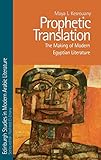Prophetic Translation : The Making of Modern Egyptian Literature / Maya I. Kesrouany.
Material type: TextSeries: Edinburgh Studies in Modern Arabic Literature : ESMALPublisher: Edinburgh : Edinburgh University Press, [2022]Copyright date: ©2019Description: 1 online resource (264 p.)Content type:
TextSeries: Edinburgh Studies in Modern Arabic Literature : ESMALPublisher: Edinburgh : Edinburgh University Press, [2022]Copyright date: ©2019Description: 1 online resource (264 p.)Content type: - 9781474407403
- 9781474407410
- Arabic fiction -- 1801- -- History and criticism
- Arabic fiction -- Egypt -- History and criticism
- English fiction -- Translations into Arabic -- History and criticism
- French fiction -- Translations into Arabic -- History and criticism
- Islamic Studies
- HISTORY / Middle East / Egypt (see also Ancient / Egypt)
- 892.709962 23
- PJ8212
- online - DeGruyter
| Item type | Current library | Call number | URL | Status | Notes | Barcode | |
|---|---|---|---|---|---|---|---|
 eBook
eBook
|
Biblioteca "Angelicum" Pont. Univ. S.Tommaso d'Aquino Nuvola online | online - DeGruyter (Browse shelf(Opens below)) | Online access | Not for loan (Accesso limitato) | Accesso per gli utenti autorizzati / Access for authorized users | (dgr)9781474407410 |
Frontmatter -- Contents -- Series Editor’s Foreword -- Acknowledgements -- Introduction Prophetic Tendencies: Egyptian Translators of the Twentieth Century -- 1 Translation in Motion: A Survey of Literary Translation in Lebanon and Egypt during the Nahḍa -- 2 Plagiarised Prophecy in the Romantic Works of al-Manfalūṭī, al-ʿAqqād and al-Māzinī -- 3 The Hero at Home: Muḥammad al-Sibāʿī and Thomas Carlyle -- 4 Tarjama as Debt: The Making of a Secular History of Arabic Literature -- Conclusion The Prophet Today: The Novel in Distress -- Bibliography -- Index
restricted access online access with authorization star
http://purl.org/coar/access_right/c_16ec
Considers the changing role of literary translation in Egypt from the 1910s to the 1940sIn this novel and pioneering study Maya I. Kesrouany explores the move from Qur’anic to secular approaches to literature in early 20th-century Egyptian literary translations, asking what we can learn from that period and the promise that translation held for the Egyptian writers of fiction at that time. Through their early adaptations, these writers crafted a prophetic, secular vocation for the narrator that gave access to a world of linguistic creation and interpretation unavailable to the common reader or the religious cleric. This book looks at the writers’ claim to secular prophecy as it manifests itself in the adapted narrative voice of their translations to suggest an original sense of literary resistance to colonial oppression and occupation in the early Arabic novel. Key FeaturesCase studies of Arabic adaptations of European literature (including works from Chateaubriand, Carlyle, Dickens and Voltaire) contribute to an understanding of the development of the modern Arabic novel today Explores the exchange between the Arabic and the European novel in an original and radically comparative frameworkShows how different translation trends signal the emergence of literature as a historical and aesthetic fieldDraws on translation, literary and post/colonial theory to rethink nahda literature’s contribution to the post 1950s Arabic novel
Mode of access: Internet via World Wide Web.
In English.
Description based on online resource; title from PDF title page (publisher's Web site, viewed 29. Jun 2022)


